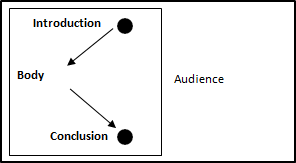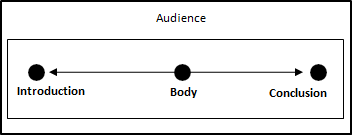Delivering a Presentation
Adapting to your physical space while giving a speech will help you monitor your volume, engage the entire audience, and maintain control of the presentation. Below are some tips for improving your speech by taking advantage of the space around you.
If possible, check out your presentation space beforehand. Examine the room and make sure you can move around any equipment. If you plan on using a podium, make sure it is adjusted to suit your height. Test the microphone, laser pointer, and slide projector to be sure they work and that you know how to use them.
In addition, consider using left-to-right space appropriately. People respond to visual change, so an effective way to keep your audience’s attention is to move left to right every time you transition in your speech. The use of different parts of the stage for different parts of your speech is an efficient way to visually organize your content and maintain audience attention.
Keep in mind that there may be people in the audience who need special consideration because of a disability, such as a hearing impairment. If you move around the space, don’t speak while you’re moving. Wait until you’re again facing the audience full on before you resume talking. That way your voice will carry more for those who may be hard of hearing, and individuals trying to lip read will be able to see your face. Likewise, if you turn in order to point out something on a slide, turn back to the audience before you resume speaking.
You can move out from behind the podium to emphasize parts of your speech. A podium is associated with more formal styles of speaking, so if you want to be more informal or get close to your audience to make an impact, don’t use one.
Don’t stand in front of the light source, since doing so can create a shadow on your slides, and don’t block the slides with your body or angle your body toward the projection too much. Stand slightly to the left or right and use a laser pointer if needed. Remote controls are also helpful for advancing slides without having to move back and forth to a computer.
Consider making information on your slides available in hard or electronic copy as well, so that audience members can review it before or after your presentation. This is also helpful for those audience members who may have trouble processing or retaining information presented orally.



If possible, check out your presentation space beforehand. Examine the room and make sure you can move around any equipment. If you plan on using a podium, make sure it is adjusted to suit your height. Test the microphone, laser pointer, and slide projector to be sure they work and that you know how to use them.
Space and Proximity
Before your speech, consider how to use the available space and how close you will be to your audience. Crouching down slightly can be a good way to share “secrets” with your audience, while standing tall with hands raised can call attention to important points or heighten emotion. A step towards your audience can draw them in and emphasize your point, while a step backward may be used to show reservation or hesitation.In addition, consider using left-to-right space appropriately. People respond to visual change, so an effective way to keep your audience’s attention is to move left to right every time you transition in your speech. The use of different parts of the stage for different parts of your speech is an efficient way to visually organize your content and maintain audience attention.
Keep in mind that there may be people in the audience who need special consideration because of a disability, such as a hearing impairment. If you move around the space, don’t speak while you’re moving. Wait until you’re again facing the audience full on before you resume talking. That way your voice will carry more for those who may be hard of hearing, and individuals trying to lip read will be able to see your face. Likewise, if you turn in order to point out something on a slide, turn back to the audience before you resume speaking.
Podiums
A podium allows speakers a place to rest their arms or notes. The height of the podium and microphone should be adjusted so that they don’t obstruct the audience’s view of your face. Be sure to use hand gestures rather than gripping the podium and appearing nervous. Look out at your audience, not down at your notes.You can move out from behind the podium to emphasize parts of your speech. A podium is associated with more formal styles of speaking, so if you want to be more informal or get close to your audience to make an impact, don’t use one.
Slides or Overheads
Be aware of lighting: it’s best not to darken a room too much because the audience needs to see you, not just a set of slides. You are more persuasive when your facial expressions and gestures are visible; you never want your slides to overpower your presence.Don’t stand in front of the light source, since doing so can create a shadow on your slides, and don’t block the slides with your body or angle your body toward the projection too much. Stand slightly to the left or right and use a laser pointer if needed. Remote controls are also helpful for advancing slides without having to move back and forth to a computer.
Consider making information on your slides available in hard or electronic copy as well, so that audience members can review it before or after your presentation. This is also helpful for those audience members who may have trouble processing or retaining information presented orally.
Large Rooms
Large rooms and auditoriums can be a challenge to orators. With a large audience, there is a risk of excluding people sitting in the back or on the sides. Also, in large spaces, speakers are often subjected to bright lights on stage, which makes seeing the audience difficult. To work around these problems, try coordinating your speaking points to places on stage. Move around for each section of the speech, as suggested in the figure below:

Small Rooms
Small rooms and intimate spaces allow the speaker to see the audience’s reaction easily and to connect through eye contact. The speaker might also connect by talking to specific people or walking close to them. Sometimes a microphone isn’t needed, but be sure to ask the audience in the back if they can hear your normal voice before you forego the microphone—you may think you can shout through your presentation, but eventually you will sound strained. Stand up so you’re visible. You can create interest and emphasize your points in a small space by walking in a straight line: